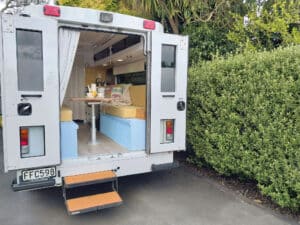Choosing the right camera system with the best resolution for your setup can make a huge difference. Peta Stavelli talks to the specialist team at RSE to learn more about the latest camera system technology.
Anyone who’s taken an RV on the road will know that a good camera system is worth its weight in gold. Whether you’re reversing, watching your rear on the road, trying to park up or you need a way of keeping everything safe and sound, having the right equipment is key.
Technology has come a very long way in recent years, and if you’re looking to buy a new camera system for your vehicle, it’s worth investing in the latest generation technology. These days, this differs vastly from older models; now these cameras offer television-grade clarity, and multiple camera options that can be tailored to your specific needs, so you can use it for whatever suits you. Investing wisely in the very latest in technology, with Full HD (high definition) quality of 1080p, is something the expert team at RSE knows a lot about. It makes a massive difference in viewing quality when compared to the standard HD of 720p, and you have the option of up to four separate cameras keeping watch on the things you value – whether that be tow hitches, bike racks or inside your horse trailers; in fact anywhere you require a good set of eyes. Wireless cameras also offer the option of audio recording, for those who favour a more conventional dash-cam capacity.
Spoiled for choice
With so many options to choose from, making the right investment can be quite confusing when you’re starting out. How do you know which system will best suit your rig and your needs? That’s where an expert opinion can make all the difference. RSE has always been a leader in developing and promoting new technology. Their electronic products frequently set new industry standards that then become the benchmark for others to follow. Their staff are always right across the latest products, and they’re happy to explain the merits of different systems.
Expert Assistance
I asked RSE’s workshop coordinator, Robert Pike, to explain the differences between wired and wireless technology, breaking down the benefits of each system simply, so that even a technophobe like myself could understand. He says the company’s new generation 1080p resolution rear cameras offer a marked difference in picture clarity when compared with their predecessors.

Why Buy?
We began by discussing why customers want to buy a camera system in the first place. “Foremost for many people is the security of an improved rear view when reversing; however the new systems can also offer the personal security of seeing that boat, caravan or trailer connections are still secure,” he says. “It can even be as specific as checking your bike covers are still on. If you’re travelling with animals – say, in a horse float or hunting dog trailer – you can check on their welfare while you are driving.”
The beauty of the new technology at RSE is that the monitor and camera systems are compatible with most vehicle or camper types, and they continue to work for you, even when you’re stationary offering an eye on your rig and equipment for extra peace of mind.
Wired or Wireless?
Different systems suit different people, and Robert suggests customers consider factors such as the costs and challenges of installation, the number of cameras needed now, and also any potential future needs. That’s where understanding the differences between wired and unwired systems can be helpful. Getting wired: As the name suggests, wired camera systems offer connectivity between a camera and a monitor via a loom – or cable. Usually this is run from the dashboard-mounted or mirror monitor to the rear of a vehicle where the camera or cameras are installed. In a towed vehicle, like a caravan, the cable will extend from the dashboard, via the draw bar, right through to the rear of the trailer through the trailer wiring kit. And wireless? Of course wireless technology – as the name suggests – dispenses with the need for cables, by using wireless transmission technology to convey the signal between the monitor and the camera. Power can be provided for the mirror monitor by a simple 12 volt cig plug or hard-wired into the vehicle 12V supply in the dashboard, with the camera’s secured to a reliable power source and RSE recommends this be either from the fridge circuit, or directly from the habitation battery through a park light triggered relay.
Pluses and minuses
The two systems – wired and unwired – each have pluses and minuses, and the team at RSE are happy to go into as much detail as you need. Essentially, a wired system is where the monitor provides power to the camera via the cable. People still find comfort in a hard wired solution. However it can be more time-consuming to install than a wireless system, and therefore more expensive to install. It can also be harder to upgrade or when adding in a camera. Conversely, people love a wireless camera system if they have plans to change their tow vehicle. It also takes less installation time, and can be easily transferred to another vehicle and later be upgraded when finances allow. If there is downside to wireless technology, it is the incompatibility with other camera systems.
Need to know more?
Hopefully this will bring you up to speed on this wired vs wireless camera systems. If there is one main takeaway, it is that the new Full HD system from RSE is almost as revolutionary as going from black and white to colour. But if you have any further queries, pop in to RSE and talk to a knowledgeable staff member who will help fill any gaps in your knowledge. While you are there, don’t forget to also check out their latest imports. There is always something new on offer at RSE.
Buy the RSE1080p Full HD Camera System on our website: rse.co.nz
Check out our March issue to find out more from RSE about what these huge strides in Full HD camera technology means for RVers.







